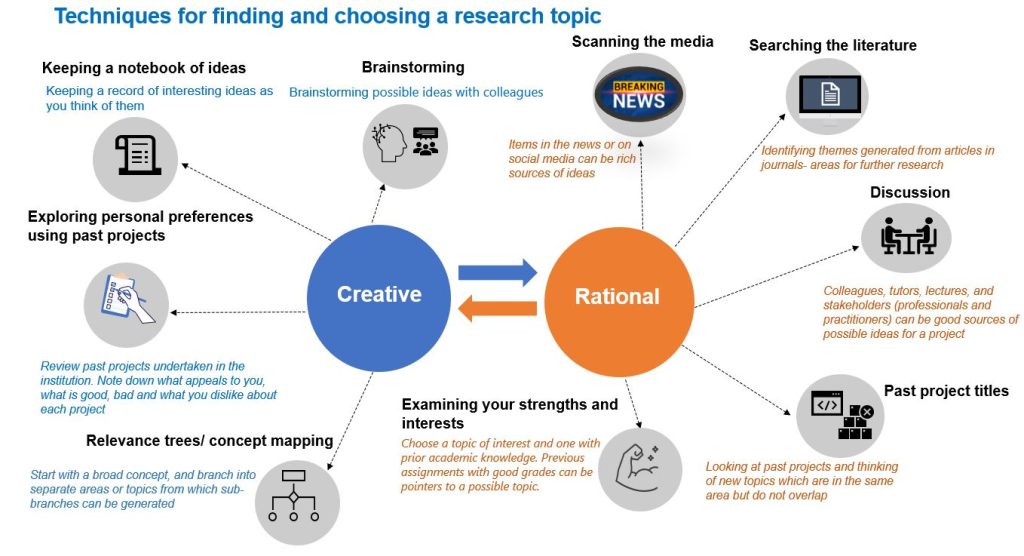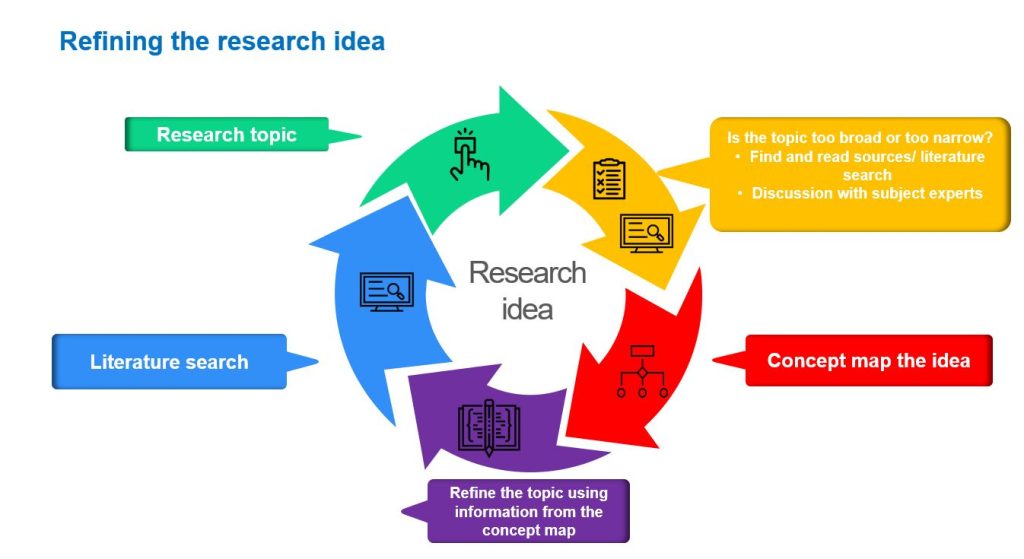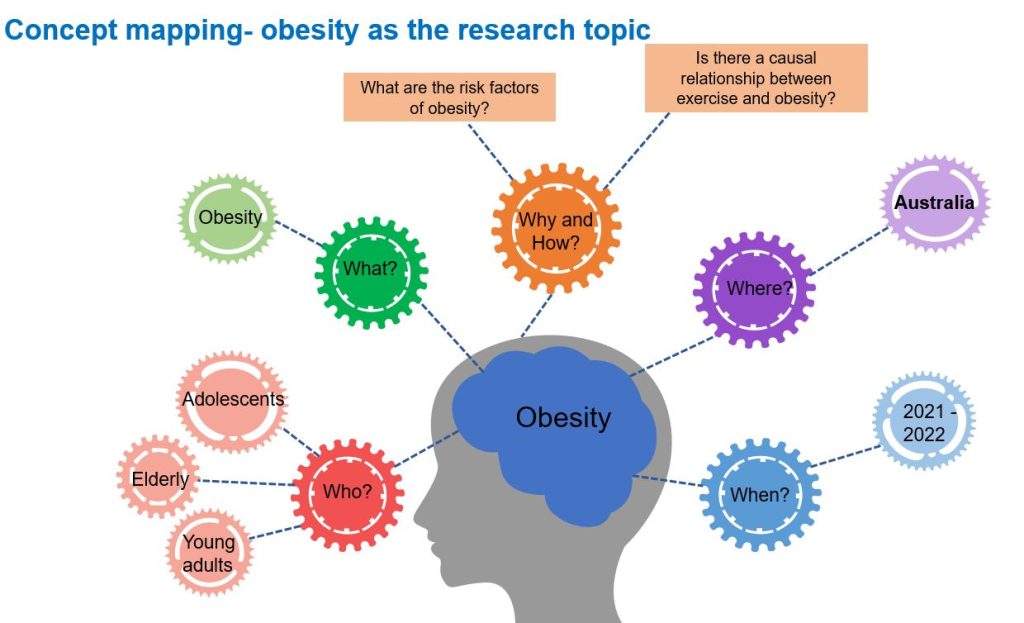2.3 Choosing a Research Topic
Many researchers assume that choosing a topic is a linear process; however, in reality, it is more complex, and the research idea may need to be refined before the topic is finally chosen. Watch the video below that explains the process of choosing a research topic.
Choosing a research idea video by Bunmi Malau-Aduli and Faith Alele, used under a CC BY NC ND 4.0 licence
Techniques for finding and choosing a research topic
There are two main approaches to finding and choosing a research topic– rational (logical) and creative (intuitive).2,3 The creative approach requires techniques such as brainstorming, keeping a record of the ideas, using relevance trees and exploring personal preferences.3,4 The rational approach, on the other hand, involves techniques such as reviewing the literature to identify knowledge gaps, discussing the ideas with subject experts, peers or stakeholders, using past project titles, scanning the media and identifying one’s strengths and interests.3,4 It is also imperative to engage in critical reflection throughout the process to ensure that the topic is relevant. As a result of this process, the topic may not only be refined but may change substantially. It is important to note that diverse techniques can be used simultaneously or iteratively to decide on a research topic.3 Figure 2.2 portrays the different techniques.

Attributes of a good research topic
As a researcher, it is important to ensure that your chosen research topic is of obvious value and benefit, financially viable and within your capabilities and interests.5 As indicated in Table 2.1, ways of assessing your capability include deciding if the topic is achievable within the time frame, whether the project will be current at completion and whether you have access to the required data.4 Furthermore, there is a need for the topic to be linked to theory, emphasising the role and importance of literature.4 This implies that the topic should be set in the context of existing literature, i.e. reading and identifying research already undertaken on that topic to guide the decision-making process about the topic selection. Also, the literature aids the refinement of research ideas and prevents research that repeats what has already been done.6 The proposed research should provide fresh insight into the topic, the aims and objectives should be clear,7 and the findings should be of similar value irrespective of the outcome (symmetrical).4 Finally, the research topic should match the researcher’s career goals.4 While this may not be the case in all instances, it is important to give it considerable thought, especially for those undertaking a dissertation. A checklist of the attributes of a good research topic is listed in Table 2.1 and serves as a guide when choosing a topic.
Table 2.1 Attributes of a good research topic. Adapted from Saunders, et al. 2003 3
Capacity: Is it feasible? |
Appropriateness: Is it worthwhile? |
| Is the topic something the researcher is interested in? | Does the topic fit the specifications set by the examining institution and related to the idea given? |
| Can the researcher develop or obtain the necessary skills within the project time frame? | Is the topic grounded in the literature (linked to theory)? |
| Is the topic achievable in the time available? | Are the research aims and objectives clearly stated? |
| Will the topic/project remain current at the end of the research? | Will the topic provide new insights (originality)? |
| Is the topic/project financially viable? | Is the topic likely to have symmetry of potential outcomes? |
| Will it be easy and feasible to assess and acquire data for the topic? | Does the topic match the researcher’s career goals? |
| Will the topic provide useful knowledge for application in clinical practice? |
Refining the research topic/idea
Remember that a research idea can be generated using rational and/or creative techniques. However, at the onset, the developed idea may be too broad or too specific and may need to be refined. Refining a research idea involves the steps outlined in Figure 2.3. First, a research topic is picked, and the topic is tested by reading the literature. If the topic is too broad, it needs to be made more focused, and if it is too specific, it needs to be broadened. The literature search and discussion with subject experts could be useful in refining the topic.2

A useful way of refining the research idea/topic is to use a concept map based on the findings from the literature or discussions to identify contextual factors or areas related to the topic.3 Let us return to our previous example of obesity as your research topic which was depicted in the video. A concept map that utilised the 5Ws and H (who, what, where, when, why and how) questions is presented in Figure 2.4 to facilitate in-depth analysis and refinement of the research topic. It is important to note that concept maps can be complex as each theme can be branched into further subthemes.

The refined topic can be further tested by searching the literature to ensure that the idea is novel and has not been previously answered. The Delphi technique is an alternative technique that could also be used to refine the topic and generate possible research questions.8 The Delphi technique entails selecting a more focused research idea via contributions from a group of people who are either working on or interested in the research topic.8 The Delphi consists of four distinct phases. In the first phase, participants can provide whatever information they deem pertinent, which explores the topic under investigation. The second stage is ascertaining how the entire group perceives the topic/idea.8 The third step is utilised to investigate any substantial disputes and identify the root causes of any identified differences. A final assessment of all the information acquired is done in the fourth step.8

